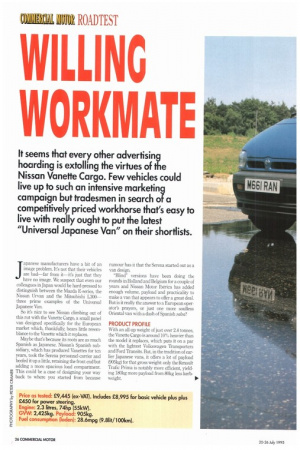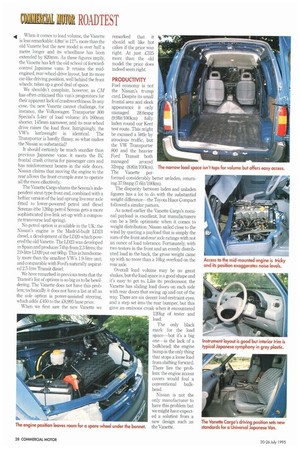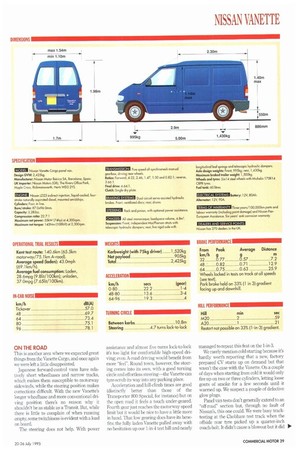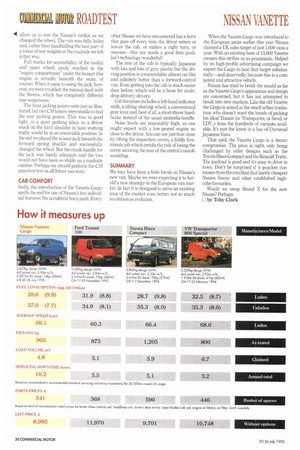WILLING INORKMAT
Page 28

Page 30

Page 31

Page 32

If you've noticed an error in this article please click here to report it so we can fix it.
It seems that every other advertising hoarding is extolling the virtues of the Nissan Vanette Cargo. Few vehicles could live up to such an intensive marketing campaign but tradesmen in search of a competitively priced workhorse that's easy to live with really ought to put the latest "Universal Japanese Van" on their shortlists.
sliapanese manufacturers have a bit of an image problem. It's not that their vehicles are bad—far from it—it's just that they have no image. We suspect that even our colleagues in Japan would be hard-pressed to distinguish between the Mazda E-series, the Nissan Urvan and the Mitsubishi L300— three prime examples of the Universal Japanese Van.
So it's nice to see Nissan climbing out of this rut with the Vanette Cargo, a small panel van designed specifically for the European market which, thankfully, bears little resemblance to the Vanette which it replaces.
Maybe that's because its roots are as much Spanish as Japanese. Nissan's Spanish subsidiary, which has produced Vanettes for ten years, took the Serena personnel-carrier and beefed it up a little, retaining the front end but adding a more spacious load compartment. This could be a case of designing your way back to where you started from because rumour has it that the Serena started out as a van design.
"Blind" versions have been doing the rounds in Holland and Belgium for a couple of years and Nissan Motor Iberica has added enough volume, payload and practicality to make a van that appears to offer a great deal. But is it really the answer to a European operator's prayers, or just one more soulless Oriental van with a dash of Spanish salsa?
PRODUCT PROFILE With an all-up weight of just over 2.4 tonnes, the Vanette Cargo is around 10% heavier than the model it replaces, which puts it on a par with the lightest Volkswagen Transporters and Ford Transits. But, in the tradition of earlier Japanese vans, it offers a lot of payload (905kg) for that gross weight: only the Renault Trafic Prima is notably more efficient, yielding 180kg more payload from 80kg less kerbweight. • When it comes to load volume, the Vanette is less remarkable: 4.8m: is 12% more than the old Vanette but the new model is over half a metre longer and its wheelbase has been extended by 820mm. As these figures imply, the Vanette has left the old school of forwardcontrol Japanese vans. It retains the midengined, rear-wheel-drive layout, but its more car-like driving position, well behind the front wheels, takes up a good deal of space.
We shouldn't complain, however, as CM has often criticised this van's progenitors for their apparent lack of crashworthiness. In any case, the new Vanette cannot challenge, for instance, the Volkswagen Transporter 800 Special's 5.4m3 of load volume: it's 160mm shorter, 145mm narrower, and its rear-wheel drive raises the load floor. Intrig-uingly, the VW's kerlal,veight is identical. The Transporter is hardly flimsy, so what makes the Nissan so substantial?
It should certainly be much sturdier than previous Japanese vans: it meets the EC frontal crash criteria for passenger cars and has reinforcement beams in the side doors. Nissan claims that moving the engine to the rear allows the front crumple zone to operate all the more effectively.
The Vanette Cargo shares the Serena's independent strut-type front end, combined with a heftier version of the leaf-sprung live rear axle fitted to lower-powered petrol and diesel Serenas (the 126hp petrol Serena gets a more sophisticated five-link set-up with a composite transverse leaf spring).
No petrol option is available in the UK: the Nissan's engine is the Madrid-built LD23 diesel, a development of the LD20 which powered the old Vanette. The LD23 was developed in Spain and produces 74hp from 2.3 litres; the 2.0-litre LD20 put out 66hp. This is handsomely more than the smallest VW's 1.9-litre unit, and comparable with Ford's naturally aspirated 2.5-litre Transit diesel.
We have remarked in previous tests that the Transit's list of options is so big as to be bewildering. The Vanette does not have this problem; technically it does not have a list at all as the sole option is power-assisted steering, which adds £450 to the £8,995 base price.
When we first saw the new Vanette we remarked that it should sell like hot cakes if the price was right. At just £325 more than the old model the price does indeed seem right.
PRODUCTIVITY
Fuel economy is not the Nissan's trump card. Despite its small frontal area and sleek appearance it only managed 28.6mpg (9.91it/100km) fully laden round our Kent test route. This might be excused a little by atrocious traffic, but the VW Transporter 800 and the heavier Ford Transit both managed around 32mpg (8.81it/100km). The Vanette performed considerably better unladen, returning 37.0mpg (7.61it/100km).
The disparity between laden and unladen figures has a lot to do with the substantial weight difference—the Toyota Hiace Compact followed a similar pattern.
As noted earlier the Vanette Cargo's nominal payload is excellent, but manufacturers can be a little optimistic when it comes to weight distribution. Nissan sailed close to the wind by quoting a payload that is simply the sum of the front and rear axle ratings with not an ounce of load tolerance. Fortunately, with two testers in the front and an evenly distributed load in the back, the gross weight catne up with no more than a 10kg overload on the rear axle.
Overall load volume may be no great shakes, but the load space is a good shape and it's easy to get to. Like its predecessor, the Vanette has sliding load doors on each side with rear doors that swing up and out of the way. There are six decent load-restraint eyes, and a step set into the rear bumper, but this gave an ominous creak when it encountered 120kg of tester and load.
The only black mark for the load space—but it's a big one—is the lack of a bulkhead; the engine hump is the only thing that stops a loose load from shifting forward. There lies the problem: the engine access covers would foul a conventional bulkhead.
Nissan is not the only manufacturer to have this problem but we might have expected a solution from a new design such as the Vanette.
ON THE ROAD
This is another area where we expected great things from the Vanette Cargo, and once again we were left a little disappointed.
Japanese forward-control vans have relatively short wheelbases and narrow tracks, which makes them susceptible to motorway sidewinds, while the steering position makes corrections difficult With the new Vanettes longer wheelbase and more conventional driving position there's no reason why it shouldn't be as stable as a Transit But, while there is little to complain of when running empty, some twitchiness is evident with a load on board.
The steering does not help. With power assistance and almost five turns lock-to-lock it's too light for comfortable high-speed driving; even A-road driving would benefit from more "feel". Round town, however, the steering comes into its own, with a good turning circle and effortless steering—the Vanette can tyre-scrub its way into any parking place.
Acceleration and hill-climb times are good (distinctly better than those of the Transporter 800 Special, for instance) but on the open road it feels a touch under-geared. Fourth gear just reaches the motorway speed limit but it would be nice to have a little more in hand. That low gearing does have its benefits: the fully laden Vanette pulled away with no hesitation up our 1-in-4 test hill and nearly managed to repeat this feat on the 1-in-3.
We rarely mention cold starting because it's hardly worth reporting that a new, factory prepared CV starts up on demand but that wasn't the case with the Vanette. On a couple of days when starting from cold it would only fire up on two or three cylinders, letting loose gouts of smoke for a few seconds until it warmed up. We suspect a couple of defective glow plugs.
Panel van tests don't generally extend to an "off-road" section but, through no fault of Nissan's, this one could. We were busy tracktesting at the Chobham test track when the offside rear tyre picked up a quarter-inch coach-bolt. It didn't cause a blowout but it did 0'
• allow us to test the Nissan's toolkit as we changed the wheel. The van was fully laden and, rather than handballing the best part of a tonne of test weights at the roadside we left it that way Full marks for accessibility of the toolkit and spare wheel, easily reached in the "engine compartment" under the bonnet (the engine is actually beneath the seats, of course). When it came to using the jack, however, we were troubled: the manual dealt with the Serena, which has completely different rear suspension.
The front jacking points were just as illustrated, but two CMtesters were unable to find the rear jacking points. This was in good light, in a quiet parking place so a driver stuck on the hard shoulder in busy evening traffic would be in an unenviable position. In the end we placed the scissor jack beneath the forward spring shackle and successfully changed the wheel. But the crank handle for the jack was barely adequate and the van would not have been so stable on a roadside camber. Perhaps we should perform the CM puncture test on all future van tests.
CAB COMFORT Sadly, the introduction of the Vanette Cargo spells the end for one of Nissan's few individual features: the accidental horn push. Every other Nissan we have encountered has a horn that goes off every time the driver enters or leaves the cab, or makes a right turn, or sneezes-this one needs a good firm push. Isn't technology wonderful?
The rest of the cab is typically Japanese with lots and lots of grey plastic but the driving position is commendable: almost car-like and infinitely better than a forward-control van. Even getting into the cab is much easier than before, which will be a boon for multidrop delivery drivers.
Cab furniture includes a left-hand indicator stalk, a tilting steering wheel, a conventional gear lever and, best of all, a short-throw handbrake instead of the usual umbrella-handle.
Noise levels are reasonably high, as one might expect with a low-geared engine so close to the driver. You can see just how close by lifting the inspection covers, a fiddly fiveminute job which entails the risk of losing the screw securing the rear of the central console moulding.
SUMMARY We may have been a little harsh on Nissan's new van. Maybe we were expecting it to herald a new strategy in the European van market. In fact it is designed to serve an existing area of the market even better; not so much revolution as evolution. When the Vanette Cargo was introduced to the European press earlier this year Nissan claimed a UK sales target of just 1,000 vans a year. With an existing base of 15,000 Vanette owners this strikes us as pessimistic. Helped by its high-profile advertising campaign we expect the Cargo to beat that target substantially-and deservedly, because this is a competent and attractive vehicle.
Nissan has fried to break the mould as far as the Vanette Cargo's appearance and design are concerned, but it has not attempted to break into new markets. Like the old Vanette the Cargo is aimed at the small urban tradesman who doesn't want the hassle of picking his ideal Transit (or Transporter, or Sevel, or LDV...) from the hundreds of variants available. It's just the latest in a line of Universal Japanese Vans.
That said, the Vanette Cargo is a decent compromise. The price is right, only being challenged by older designs such as the Toyota Hiace Compact and the Renault Trafic. The payload is good and it's easy to drive in town. Don't be surprised if it poaches customers from the excellent (but barely cheaper) Nissan Sunny and other established highcube favourites.
Would we swap Brand X for the new Nissan? Perhaps.
by Toby Clark




























































































